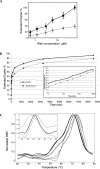Influence of C-5 halogenation of uridines on hairpin versus duplex RNA folding
- PMID: 17630326
- PMCID: PMC1950758
- DOI: 10.1261/rna.408507
Influence of C-5 halogenation of uridines on hairpin versus duplex RNA folding
Abstract
Halogenation of bases is a widespread method used for solving crystal structures of nucleic acids. However, this modification may have important consequences on RNA folding and thus on the success of crystallization. We have used a combination of UV thermal melting, steady-state fluorescence, X-ray crystallography, and gel electrophoresis techniques to study the influence of uridine halogenation (bromination or iodination) on the RNA folding. The HIV-1 Dimerization Initiation Site is an RNA hairpin that can adopt an alternative duplex conformation and was used as a model. We have shown that, unexpectedly, the RNA hairpin/duplex ratio is strongly dependent not only on the presence but also on the position of halogenation.
Figures




Similar articles
-
Mechanism of hairpin-duplex conversion for the HIV-1 dimerization initiation site.J Biol Chem. 2005 Dec 2;280(48):40112-21. doi: 10.1074/jbc.M503230200. Epub 2005 Sep 15. J Biol Chem. 2005. PMID: 16169845
-
Crystal structures of coaxially stacked kissing complexes of the HIV-1 RNA dimerization initiation site.Nat Struct Biol. 2001 Dec;8(12):1064-8. doi: 10.1038/nsb727. Nat Struct Biol. 2001. PMID: 11702070
-
Kissing complex-mediated dimerisation of HIV-1 RNA: coupling extended duplex formation to ribozyme cleavage.Nucleic Acids Res. 2003 Nov 15;31(22):6419-27. doi: 10.1093/nar/gkg873. Nucleic Acids Res. 2003. PMID: 14602899 Free PMC article.
-
A structure-based approach for targeting the HIV-1 genomic RNA dimerization initiation site.Biochimie. 2007 Oct;89(10):1195-203. doi: 10.1016/j.biochi.2007.03.003. Epub 2007 Mar 12. Biochimie. 2007. PMID: 17434658 Review.
-
Unusual DNA duplex and hairpin motifs.Nucleic Acids Res. 2003 May 15;31(10):2461-74. doi: 10.1093/nar/gkg367. Nucleic Acids Res. 2003. PMID: 12736295 Free PMC article. Review.
Cited by
-
A Combined Experimental and Computational Study of Halogen and Hydrogen Bonding in Molecular Salts of 5-Bromocytosine.Molecules. 2021 May 23;26(11):3111. doi: 10.3390/molecules26113111. Molecules. 2021. PMID: 34070959 Free PMC article.
-
Engineering Crystal Packing in RNA Structures I: Past and Future Strategies for Engineering RNA Packing in Crystals.Crystals (Basel). 2021 Aug;11(8):952. doi: 10.3390/cryst11080952. Epub 2021 Aug 15. Crystals (Basel). 2021. PMID: 34745656 Free PMC article.
-
A fast selenium derivatization strategy for crystallization and phasing of RNA structures.RNA. 2009 Apr;15(4):707-15. doi: 10.1261/rna.1499309. Epub 2009 Feb 18. RNA. 2009. PMID: 19228585 Free PMC article.
-
An atlas of RNA base pairs involving modified nucleobases with optimal geometries and accurate energies.Nucleic Acids Res. 2015 Aug 18;43(14):6714-29. doi: 10.1093/nar/gkv606. Epub 2015 Jun 27. Nucleic Acids Res. 2015. PMID: 26117545 Free PMC article.
-
A Comprehensive Ab Initio Study of Halogenated A···U and G···C Base Pair Geometries and Energies.Int J Mol Sci. 2023 Mar 14;24(6):5530. doi: 10.3390/ijms24065530. Int J Mol Sci. 2023. PMID: 36982603 Free PMC article.
References
-
- Bernacchi, S., Ennifar, E., Toth, K., Walter, P., Langowski, J., Dumas, P. Mechanism of hairpin–duplex conversion for the HIV-1 dimerization initiation site. J. Biol. Chem. 2005;280:40112–40121. - PubMed
-
- Brunger, A.T., Adams, P.D., Clore, G.M., DeLano, W.L., Gros, P., Grosse-Kunstleve, R.W., Jiang, J.S., Kuszewski, J., Nilges, M., Pannu, N.S., et al. Crystallography & NMR system: A new software suite for macromolecular structure determination. Acta Crystallogr. D Biol. Crystallogr. 1998;54:905–921. - PubMed
Publication types
MeSH terms
Substances
LinkOut - more resources
Full Text Sources
Miscellaneous
